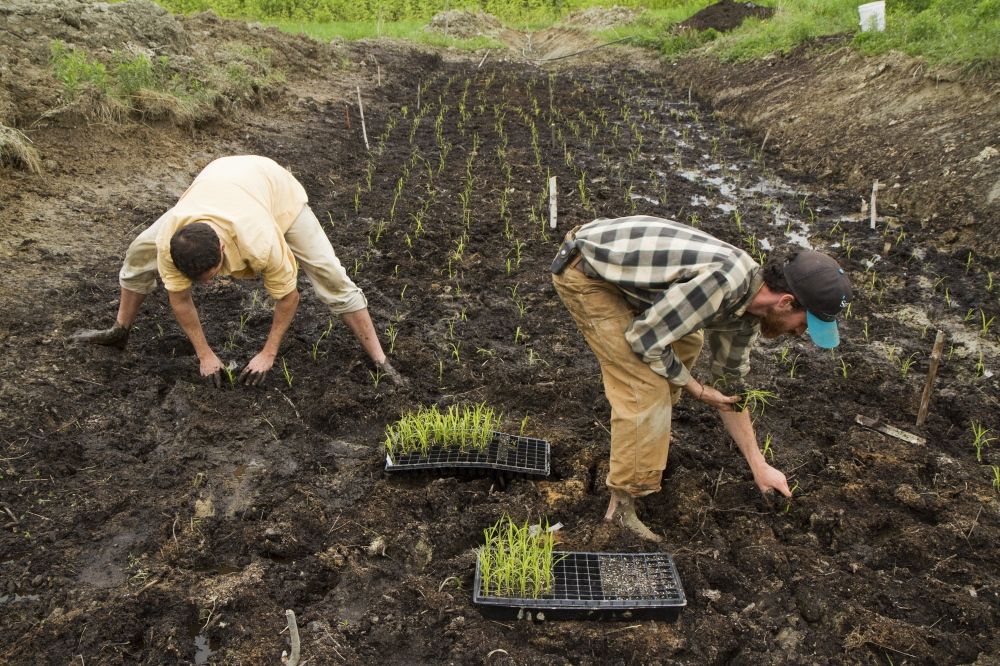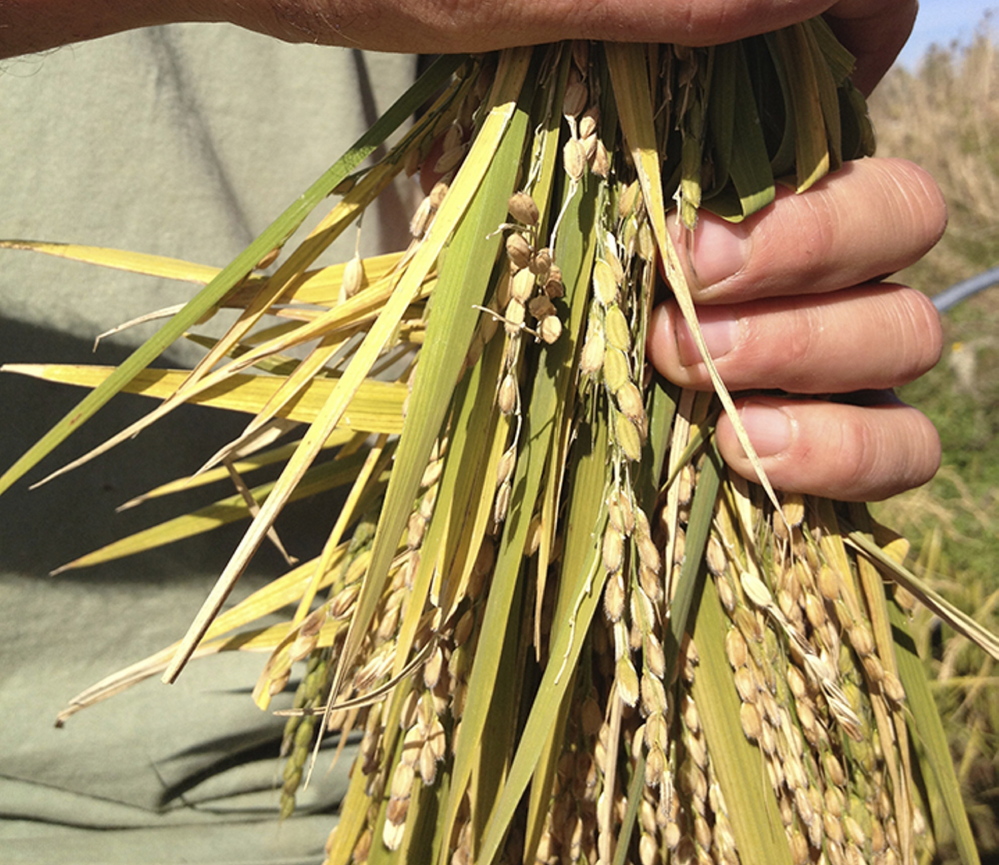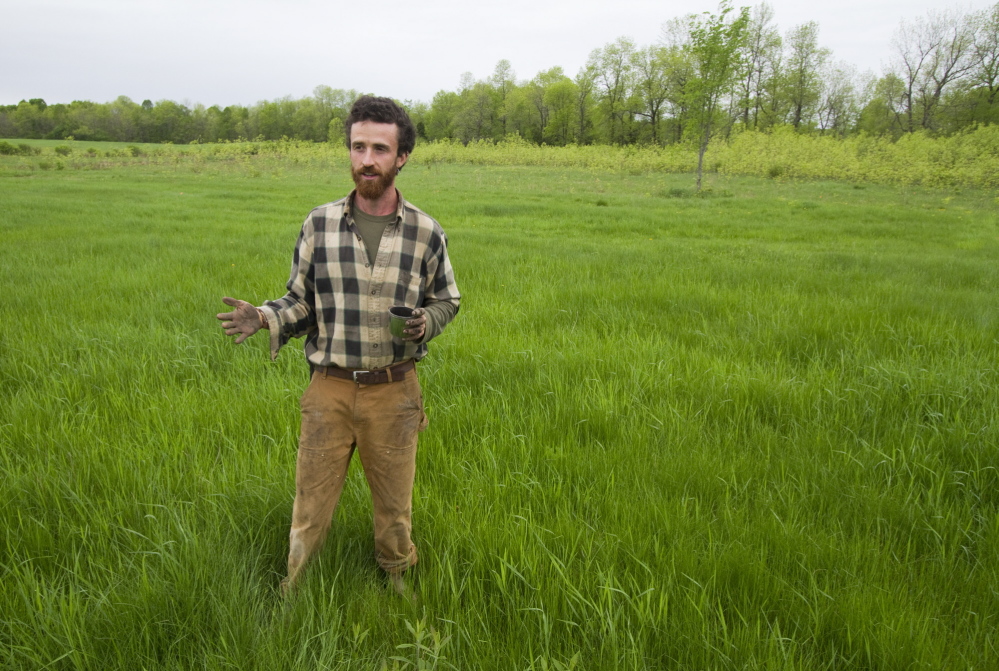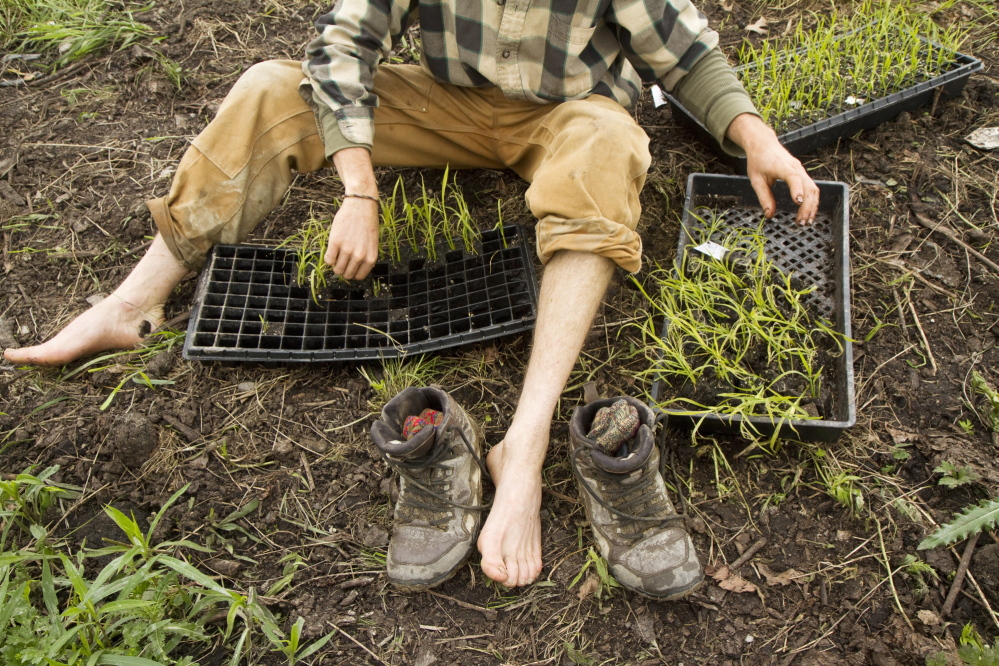Rain was coming and David Gulak and Ben Rooney were barefoot in the bottom of a hole in Benton. Nearly black mud oozed up around their ankles, and their hands and forearms were caked with it. The co-founders of Wild Folk Farm looked more like a pair of overgrown boys enjoying mud season in Maine than agricultural innovators. Yet with each slender seedling they pressed into the muck, they were pushing the boundaries of Maine farming.
The crop they were planting is rice, the hole is actually a paddy and Gulak and Rooney are trying to produce Maine’s first commercially grown rice.
It’s not utterly unheard in other parts of New England and there may be a (brief) history of growing it in Maine. Rooney said he believes some back-to-the-landers in Maine decades ago grew smatterings of rice to feed their families, although only varieties grown dry.
But as a new rice culture sprang up in Vermont in recent years, with farmers planting rice in paddies in wet areas including the Champlain Valley region, their success has sparked a new interest in the crop in Maine. Roberta Bailey of Seven Tree Farm in Vassalboro raises Duborskian rice, a short grain Russian variety, for sale to Fedco and other seed companies (she did trials of eight varieties about seven years ago; the Duborskian was the only one to reach maturity). Seedsaving expert Will Bonsall is experimenting with various early varieties, including Duborskian, in Industry to see what rice might have a fighting chance in Maine’s short growing season. In Bowdoin, a high school teacher with a passion for Asian culture is dabbling in a mini rice paddy, with the thought of raising enough rice to eat and perhaps turn into sake.
But until Gulak and Rooney met and bonded over a parcel of extremely marginal soil near Fairfield – land that area farmers wanted no part of, the kind of dirt that could be had for a song – no one has bothered with any kind of commercial rice venture in Maine. The Wild Folk Farm operation, now in its second year and being funded by a $5,000 grant from the Libra Future Fund, is the first. But its instigators don’t want it to be the last. “The main purpose is that we can help other people grow rice in Maine,” Rooney said.
According to models run by a Colby College GIS (Geographic Information System) specialist, Maine has up to 110,000 acres of just the kind of territory that could work for rice production: marginal, clay, not good for much else. So while on some level the experiment at Wild Folk Farm is a bold one – bold as in both new and complicated enough to make Bonsall and Bailey slightly skeptical – these farmers believe it is a practical way of dealing with problematic soil.
Gulak and Rooney want to increase Maine’s ability to feed its own people, from all segments of the nutritional panoply. The state has potatoes for starch, and a burgeoning industry in grains like wheat and corn. What if we could add rice to the equation, using land that hasn’t been tapped because of what it lacks?
“There is so much marginal clay soil in the state,” Rooney said, sounding almost dreamy about something most would dismiss as undesirable.
Certainly he dreams big. Holding a slim seedling in his hand, Rooney demonstrated how planting might be in future years, when their planned network of six to eight paddies was well established and they’d be planting roughly 44,000 seedlings, versus the 1,000 they were putting in the ground on this chilly May day. “Then we can just toss the seedlings,” he said. “So you just walk through the paddy, dropping them into the ground. And they’ll send out tillers and root themselves.”
That’s the way it’s done in Asia, and that’s the model he aspires to, even in a climate known for its hard winters and short summers. There might be a brief growing season, but looking out over the challenging landscape of Wild Folk Farm and imagining a series of paddies leading all the way to the seasonal stream, those green stalks against the reflecting water, was an enticing prospect on many levels, including aesthetic. Nothing says serenity quite like a rice paddy. Rooney’s original interest in growing rice stemmed from traveling in the Philippines, where he saw rice grow in its more natural habitat.
Travels in Asia have also fueled Bowdoin resident Ian Ramsey’s much smaller scale rice experiment in his home garden. The son of Maine homesteaders, he’s no junior varsity gardener. He’s also spent a lot of time in Vietnam and Japan, including taking groups of students on trips (he is a music teacher at North Yarmouth Academy) and his experiences there made him curious about the crop. Maybe he could make his own sake even. “I’m giving myself a couple of years to experiment,” he said. “I’m as interested in rice culture as anything else.” The very wet land he lives on in Bowdoin seemed suited. This year he ordered seed from Fedco (that would be Bailey’s seed) to start a mini rice paddy, just 4 feet by 4 feet. Yes, he had to dig the paddy out by hand, and yes, it was back breaking. But those paddies in Vietnam and Japan were inspirational, vast numbers of them hand dug hundreds of years ago and still flourishing.
CHEAP LAND
In 2007, Gulak’s mother helped him buy the 45-acre parcel right on the Benton-Clinton line. No electricity, no house and not expensive. It was the leftover from a failing development. She was, he said, looking to get out of the stock market and make a different kind of investment. “She told me, ‘I’ll buy the land and you can work it. Grow me some vegetables,'” Gulak remembered.
In doing so, he learned more about the land’s limitations; there was certainly a reason none of the other farmers in the area had scooped it up. Thirty acres of it are woodlands, which the “intentional community,” as they’re calling themselves (sounding like Gwyneth Paltrow talking about her “conscious uncoupling,” also known as a divorce), will use to heat their rudimentary dwellings.
The cleared land was decent pastureland – in fact Wild Folk Farm borders on the Flood Brothers Dairy in Clinton – but to grow those vegetables meant piling amendments – nutrients to feed the soil – on top of the clay. Gulak’s mother got her vegetables and then some; in those first two years, Gulak ran a small CSA, but the land wasn’t built for the classic Maine vegetable and produce farm. Meanwhile, he was building a thriving cooperative in nearby Waterville, Barrels Community Marketplace. The farm wasn’t a huge priority, but Rooney’s arrival after an introduction through friends changed that.
“This would still be a casual farm if it weren’t for Ben,” Gulak said.
Rooney, a Colby graduate who worked for Cultivating Community and had apprenticed at a few farms, floated the idea of growing rice last year. (Rooney is a MOFGA Journeyperson, one of the apprentice farmers taking classes and working with mentors through the Maine Organic Farmers and Gardeners Association’s program). He read a book called “The Power of Duck: Integrated Rice and Duck Farming” by Japanese farmer Takao Furuno, which further inspired him. A trip he took to Vermont for workshops on cultivating rice with Vermonters who had done it fired him up to get serious about planting rice.
In the spring of 2013 he and Gulak and friends dug a mini-rice paddy with hand tools. It was small, about 10 feet by 10. He had a bag of seed, the same short-grained variety, hayayuki, that they grow in Vermont, which he’d gotten from USDA. About 60 percent of that seed germinated and with the resulting seedlings, they put in the crop. Transporting water by hand from their farm pond, they filled up the paddy. In September, they drained the paddy, and harvested and threshed the rice. The seed yield was decent. Then they dug in to the results. “It tasted almost like a risotto,” Rooney said. “Really creamy. I was just so amazed. It had such a fresh flavor. Different. The way a fresh tomato tastes so different from a month-old, store-bought tomato.” They definitely wanted to grow more of this stuff.
LAPTOPS AND FARMING
The mindset at Wild Folk Farm is hand tools only, no mechanical farming. But Rooney’s vision is for the farm to eventually have several acres of rice paddies. Digging those by hand was a task that daunted even these two. They might have help from occasional apprentices, but to do it right, they needed a drainage system of some sort, even rudimentary. Over the winter Rooney spent time in Austin and then with his family in Chicago. He researched. And with an eye toward the type of backhoe excavation they’d be needing to build real paddies, he applied for grants. “I spent a lot more time on the computer than I would expect for a farmer,” he said.
“We were pretty impressed with the amount of research that he’d done,” said Erik Hayward, the vice president of the Libra Foundation. Libra’s Future Fund is designed for young entrepreneurs, aged 18 to 29, who are developing economic opportunities for Mainers. That’s the same demographic that is showing a growing interest in farming, so Rooney’s application had a natural appeal. “What we’ve thought is that perhaps there is some benefit from looking at farming in a different way, looking at crops that might have been grown historically in Maine,” Hayward said. “Rice seems to fit that bill since it can be done well in these wet clay soils.”
Included in Wild Folk Farm application was a GIS survey of the state that supported the notion that rice could be right for the state. Not the whole state, but roughly 110,000 acres of it. Rooney had gone back to Colby and enlisted the help of Manny Gimond, a Geographic Information System specialist Gulak knew. Gimond, who teaches classes in GIS technology, was instantly intrigued with the idea of finding suitable land in Maine for this sub-tropical plant. In January, he sat down with computer maps of the state, including elevations, ground cover and soil types, looking specifically for what the USDA has characterized as poorly drained or very poorly drained. Overlaying all the data with the GIS software, he came up with the 110,000-acre figure. “That’s an underestimate because I didn’t have soil estimates for the whole state,” he said.
They couldn’t have found a more enthusiastic partner. “I thought, to diversify our food production here and to make this region a little more self reliant would be wonderful,” Gimond said. And beyond the political, he’s got a personal interest. Gimond is also a homesteader with a farmhouse in Benton just down the road from Wild Folk Farm. He grows traditional crops, including asparagus and strawberries, and he has fruit trees, but he’s also got a lot of that clay soil and “Maybe now I can throw in rice,” he said.
THE POWER OF DUCK (AND DIRT)
That clay soil provides the base that can retain water. But Rooney has amended the soil at the bottom of the paddy. After the hole was dug – to very careful specifications since these things have to be level or very near level – Rooney began amendments of compost and rocks and minerals, including granite meal, a by-product of the process of cutting granite slabs.
“I call him the soil magician,” Gulak said.
That same base of heavy, wet clay has served Bailey’s rice project in Vassalboro well. She grows about 20 pounds of the Dubroskian rice on her farm but says she could, in theory, grow thousands of pounds if she wanted, using extensive mulching to keep down the weeds. That’s why she’s skeptical of the Wild Folk Farm strategy. “Why go to all that work,” she asked, “when you can just plant it in the ground? It seems like a hell of a lot of work to create that infrastructure.” But she admits she doesn’t know the answer. Maybe the yields will be better. Maybe the “power of duck” will make all the difference.
Rooney and Gulak are counting on it. They’re mimicking Furuno’s method of growing rice, an integrated system designed for minimal work and optimal yields.
The water in the paddies will keep down undesirable weeds, but a key component of keeping the system going, and continuing to enrich that soil, will be a combination of desirable weeds and ducks. Rooney is cultivating azolla weed in a greenhouse, then he’ll toss it into the paddy and let it spread. Then they’ll introduce ducks to the system to feed on the azolla. The Khaki Campbell ducks, a domesticated cross breed Rooney picked because they’re good foragers, will process the aolla through their systems and thus fertilize the paddy themselves. The ducks’ movements through the water are also apparently beneficial to the plants.
“Each year the paddy is going to get more and more fertile,” Rooney said. “We’re going to let time and biology provide that energy we need.” Eventually they hope to have 100 ducks per acre swimming around in the paddies and each year, the ducks will become meat, for the intentional community to eat and sell.
But because this is all in early stages, Rooney is proceeding with caution. Wild Folk Farm had great germination rates from the seed they collected last year–95 percent of the seed sprouted. But in Vermont last spring, rice growing guru Ben Falk of Moretown experienced what he called “epicfail” of rice seed germination, and Rooney is trying to safeguard against any epic fails at Wild Folk Farm.
Thus this year’s paddy is bigger than last year’s, but it’s still small. Next year they’ll expand to a full acre, likely spread out over six to eight paddies. “With this, we’re definitely trying to emulate what we’re going to be doing on a bigger scale,” he said. That’s because New England rice is still a dicey proposition. These visions of hundreds of happy ducks and several acres of rice, are for later, down the road. For now there will be a half dozen or so, about 1,000 plants, and they hope, some excellent fresh rice come fall.
Send questions/comments to the editors.







Success. Please wait for the page to reload. If the page does not reload within 5 seconds, please refresh the page.
Enter your email and password to access comments.
Hi, to comment on stories you must . This profile is in addition to your subscription and website login.
Already have a commenting profile? .
Invalid username/password.
Please check your email to confirm and complete your registration.
Only subscribers are eligible to post comments. Please subscribe or login first for digital access. Here’s why.
Use the form below to reset your password. When you've submitted your account email, we will send an email with a reset code.